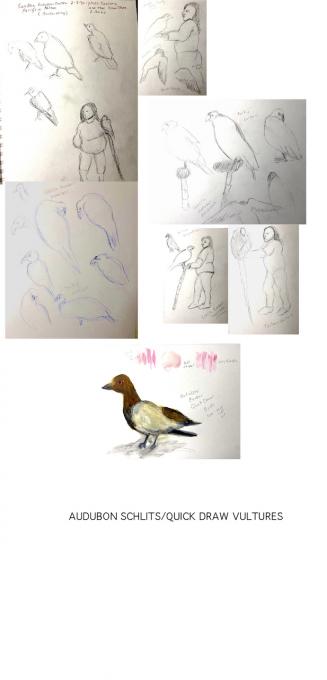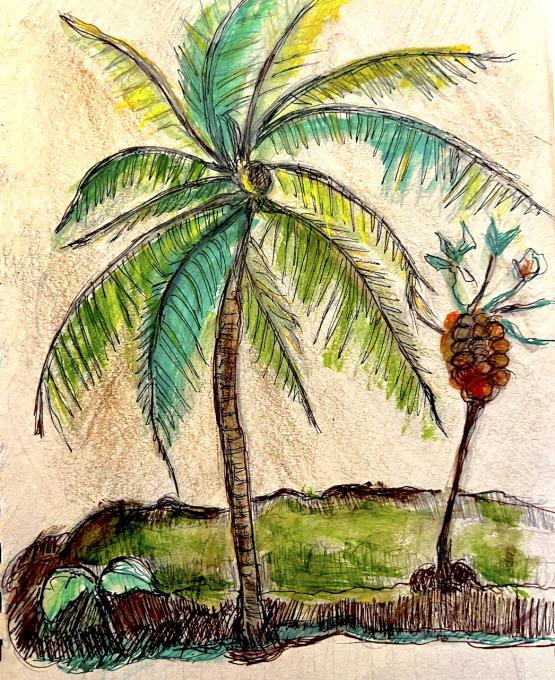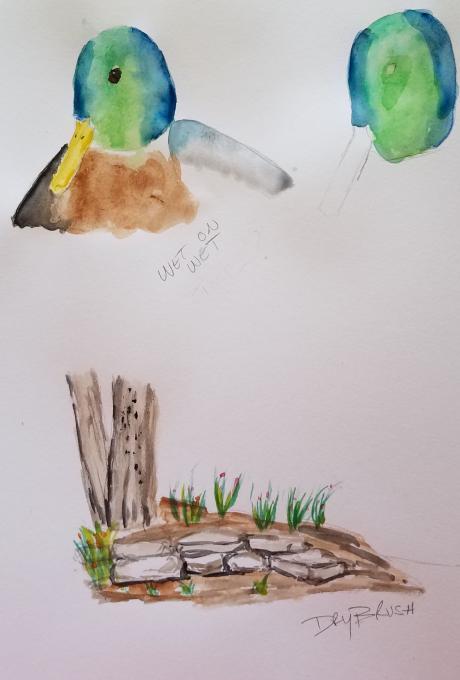The Cornell Lab Bird Academy › Discussion Groups › Nature Journaling and Field Sketching › Getting Comfortable with Watercolor
-
Bird AcademyBird Academy1. Which of the new watercolor techniques have you tried? What have you discovered using them? Any tips or experiences you’d like to share? 2. Thinking of your own journaling projects, how might you incorporate any of the new watercolor techniques in this topic to achieve your goals?You must be enrolled in the course to reply to this topic.
-
 I tried the wet on wet and the wet on dry.
I tried the wet on wet and the wet on dry. -
I tried all of the techniques for this and I really enjoyed doing them. I figured out how to spread color more evenly with the wet on wet technique in large paintings or objects that I’m painting. I think that it’s better to begin with the wet on dry (not only cause it’s the traditional way) but because it’s better for your brushes and paper because using too much water on non-watercolor paper can make things messy and bleed through and when you use a dry brush on dry paper it ruins the point of using watercolor in the first place because you might as well use acrylics or oil paints but if you don’t have them handy then it makes sense but the traditional way is the most simple and effective way to use watercolors. I could use the wet on wet technique to add some uniqueness to “play around” with some paintings but generally I would stick with the wet on dry.
-
I tried all of them for the sake of it, which was very interesting, I didn’t know there were so many options. Then I tried a full-page sketch off one of my photos. It was super fun and interesting. The more I practise watercolours the more I understand that the way I use them is complementary to my coloured pencils technique. With coloured pencils I’m very precise and try to render each minute detail of my subject, be it a plant or a bird. With watercolours I like to be less detailed, but prefer to ‘play’ around with hues more in order to highlight the overall ‘feel’ of the subject. I’m not very curious to see how I will be using watercolours on bird subjects, i.e. whether I’ll adjust my technique or still privilege broader areas of colour. Maybe I will also adjust the type of bird subject to the colour medium I’ll be using.

-
This picture is a very good example of of incorporating different techniques of watercolor. I’m assuming it’s grass and plants growing on a sandbar. I like how you left the paper white in some places to signify that they are clouds there.
-
-
Watercolor #fail#? I have found that three different watercolor half-pan sets I've bought all #fail here in Panama. Does anyone else have this problem? After i bought them (Windsor Newton, Van Gogh & Koi) I unwrap the half pans in their paper or just open box. After a few days all the watercolors melt and get stuck to the cover ofmtye container, pulled out of their respective wells. It makes a gosh darn mess! Is this a paint/company fail? Or is this weather? Anyone else? Where I live in rural Panamá is about 85-90° and 90-95% humidity. My guess is weather is the factor? Imagine the half pans kinda turning viscous, sticky and like molasses. As I close the lids on any one of my field/sketch watercolor kits the paints get stuck ok top cover, pull out most of the paint and i have to scoop it up and kinda press it back into half pan with a small knife. But I loose a ton of material. A bit frustrating. Suggestions? Ezekiel
-
I tried wet-on-wet. Wet on dry and dry. Just a quick sketch in backyard and simple colors.

-
I have primarily worked with acrylics. I have learned a great deal about watercolor from this class. I love how you can use a simple brush with water and change your color to something unexpected or, ... expected.
-
This was the first time I worked with watercolor and it was very frustrating to try to get the effects I wanted. I tried using all three techniques in the picture of my cat but wasn't happy with the results. It definitely is going to take a lot of practice. I would use this medium in the field, but probably not on a finished painting .
-

-
The pictures of the tabby is beautiful and the flowers behind really capture the vibrance of the petals. I can definitely tell that you used the all the watercolor techniques in this painting. I like how you left the wife stripes of fur blank to make the design more realistic.
-
-

-
I tried all three with the picture presented. Delicate balance of use of water…need just right amount. Still unable to figure out how to enter any picture/image into this area. Any suggestions.
-
ElizabethBird AcademyHi Candace. At the top left of the box where you enter your text reply there is a button that says “Insert Image” and if you click on that you will be able to share your photo. A new box will appear and you have the option to drag your photo over or click again to select a photo. If you need any additional help please reach out to Customer Service and someone will be happy to assist!
-
-
I tried all of the techniques. I like the wet on wet for a blurred out background effect. When I did the dry brush, which I have used with acrylic paint effective on models, my brush was too wet. I will have to keep working on it. I mainly worked on wet on dry, and did better than I thought I would. I will have to admit that going in I was worried about how well I would do with watercolor. I have only worked with it for two days, but I am thinking right now that I will probably use it only for special projects. I found that I like sketching and adding the details which at this point, I am not convinced I can do as well with watercolor.

-
 Tried using all three techniques with my female cardinal. Required lots of patience between layers. The color mixing tips were helpful to get a range of colors.
Tried using all three techniques with my female cardinal. Required lots of patience between layers. The color mixing tips were helpful to get a range of colors. -
 Tried all 3 techniques. Dry on dry was a discovery for me and achieved great textures, which will come in handy for wood. Discovered that each brus or watermen size gave a different texture effect.
Also, the exercise gave me plenty of new ideas for wet on wet, for skies and blurry objects in the distance for depth (trees, bushes)
Wet on dry was my "go to" most of the time. Will expand my techniques from now on. Thanks!
Tried all 3 techniques. Dry on dry was a discovery for me and achieved great textures, which will come in handy for wood. Discovered that each brus or watermen size gave a different texture effect.
Also, the exercise gave me plenty of new ideas for wet on wet, for skies and blurry objects in the distance for depth (trees, bushes)
Wet on dry was my "go to" most of the time. Will expand my techniques from now on. Thanks! -
It was fun to create the watercolor palette study, and to try out techniques.
 In one place or another, I experimented with all of the watercolor techniques Liz modeled in this unit’s lessons. The one I had never tried was glazing. It surprised me that colors can be layered, to some degree, in the application of watercolor pigments. My prior experiences did not include the glazing technique.
In one place or another, I experimented with all of the watercolor techniques Liz modeled in this unit’s lessons. The one I had never tried was glazing. It surprised me that colors can be layered, to some degree, in the application of watercolor pigments. My prior experiences did not include the glazing technique.
 I don’t see watercolor as a “go to” medium in my nature journal. The waterless media are more appealing to me, as is incorporation of photographs. As a nature photographer, I will likely have my “in the field” immersion and “lost in Nature” moments with my camera… followed by the addition of art media exploration to record musings, data, and factual information.
I don’t see watercolor as a “go to” medium in my nature journal. The waterless media are more appealing to me, as is incorporation of photographs. As a nature photographer, I will likely have my “in the field” immersion and “lost in Nature” moments with my camera… followed by the addition of art media exploration to record musings, data, and factual information.

-
I just did the practice painting today because I need to order new watercolors, but I can already see how the techniques can help with images. I will try the idea of creating rough textures with the dry-on-dry technique with trees. The wet-on-dry will be fun to experiment with when painting some birds with deep and vibrant colors, such as cardinals and goldfinches. Looking at other people's journal entries makes me excited to get started. I added a picture of my faulty paint set and my practice:(


-

-

-
Tip for those using pencil with watercolor (so mostly everyone) try using kneaded erasers, the help keep the occasional smear at bay. it also helps fade the pencil to make your art look neater. I never knew their was different techniques for water color! I'm definitely no pro with water colors so this course is helping a lot!
-

-


-
I think I tend to try to draw with watercolors, rather than paint - if that makes sense. The wet on dry technique works great for that. Wet on wet was fun, but I have to learn to let the paint go, and not try to control it so much. The dry on dry seemed good for suggesting texture in an area.
 Below I attempted to capture the colors of an early spring day in Connecticut. The wet on wet worked well for suggesting the light foliage and sky, and wet on dry defined most of the shapes in my landscape. I wasn't able to achieve dry on dry with the water brush.
Below I attempted to capture the colors of an early spring day in Connecticut. The wet on wet worked well for suggesting the light foliage and sky, and wet on dry defined most of the shapes in my landscape. I wasn't able to achieve dry on dry with the water brush.

-

-

-
I tried them all. Wet on wet will take alot of practice! Mine was too wet and I also noticed it buckled the paper then the color tends to pool up at least on mixed media. I am going to use colored pencils in the journal, mixing and testing colors is too much work for my journal but still will practice with the watercolors for general artwork.


Read More:
 I tried the wet on wet and the wet on dry.
I tried the wet on wet and the wet on dry. 


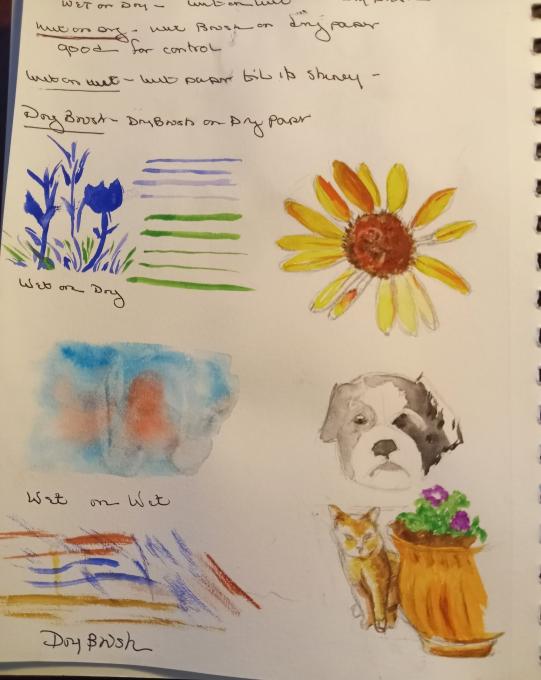

 Tried using all three techniques with my female cardinal. Required lots of patience between layers. The color mixing tips were helpful to get a range of colors.
Tried using all three techniques with my female cardinal. Required lots of patience between layers. The color mixing tips were helpful to get a range of colors. 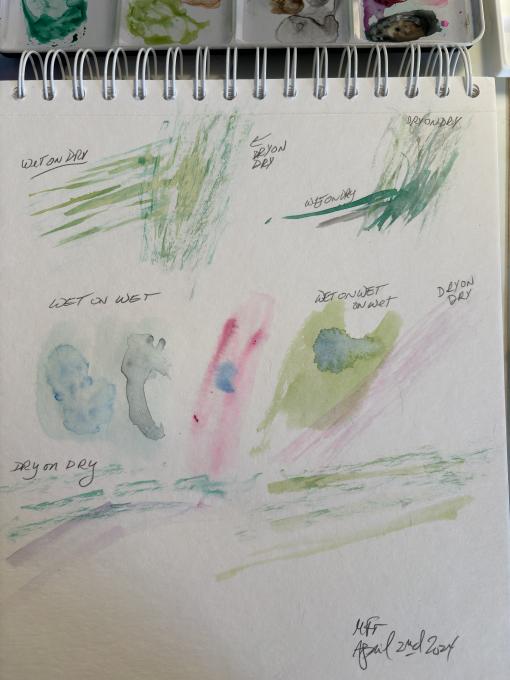 Tried all 3 techniques. Dry on dry was a discovery for me and achieved great textures, which will come in handy for wood. Discovered that each brus or watermen size gave a different texture effect.
Also, the exercise gave me plenty of new ideas for wet on wet, for skies and blurry objects in the distance for depth (trees, bushes)
Wet on dry was my "go to" most of the time. Will expand my techniques from now on. Thanks!
Tried all 3 techniques. Dry on dry was a discovery for me and achieved great textures, which will come in handy for wood. Discovered that each brus or watermen size gave a different texture effect.
Also, the exercise gave me plenty of new ideas for wet on wet, for skies and blurry objects in the distance for depth (trees, bushes)
Wet on dry was my "go to" most of the time. Will expand my techniques from now on. Thanks! 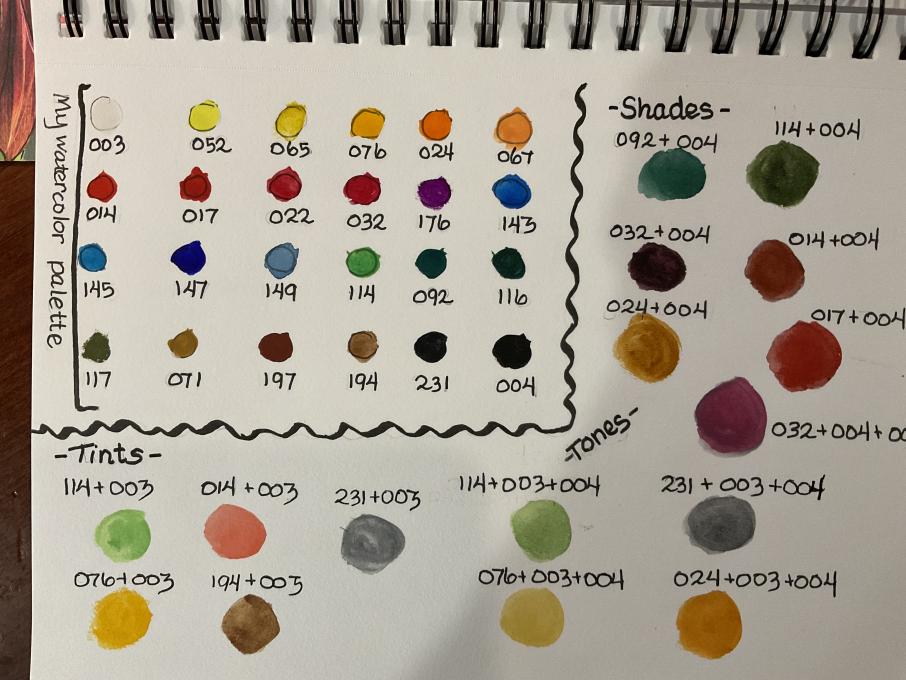 In one place or another, I experimented with all of the watercolor techniques Liz modeled in this unit’s lessons. The one I had never tried was glazing. It surprised me that colors can be layered, to some degree, in the application of watercolor pigments. My prior experiences did not include the glazing technique.
In one place or another, I experimented with all of the watercolor techniques Liz modeled in this unit’s lessons. The one I had never tried was glazing. It surprised me that colors can be layered, to some degree, in the application of watercolor pigments. My prior experiences did not include the glazing technique.
 I don’t see watercolor as a “go to” medium in my nature journal. The waterless media are more appealing to me, as is incorporation of photographs. As a nature photographer, I will likely have my “in the field” immersion and “lost in Nature” moments with my camera… followed by the addition of art media exploration to record musings, data, and factual information.
I don’t see watercolor as a “go to” medium in my nature journal. The waterless media are more appealing to me, as is incorporation of photographs. As a nature photographer, I will likely have my “in the field” immersion and “lost in Nature” moments with my camera… followed by the addition of art media exploration to record musings, data, and factual information.
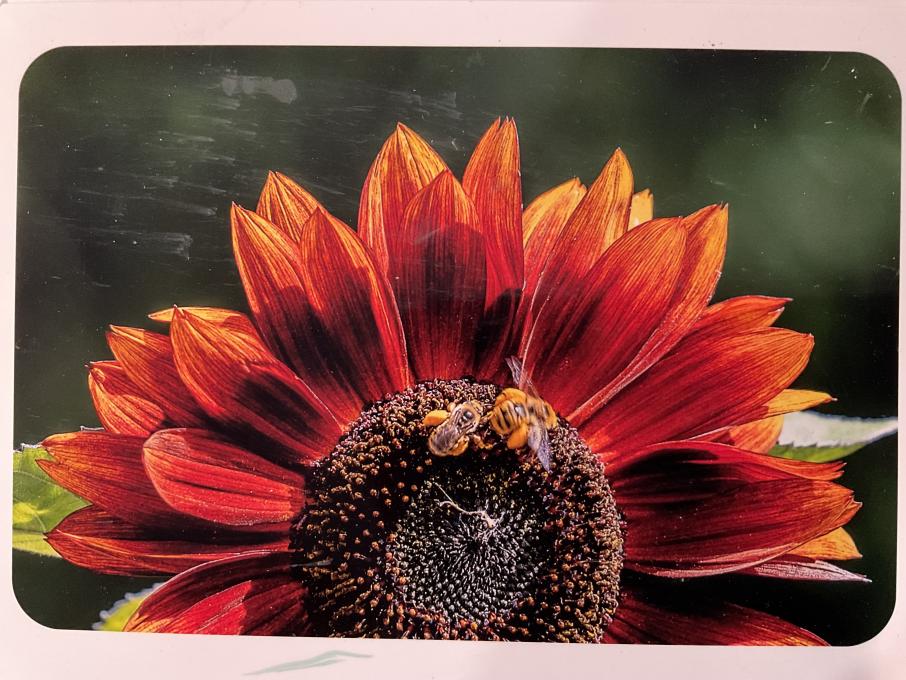

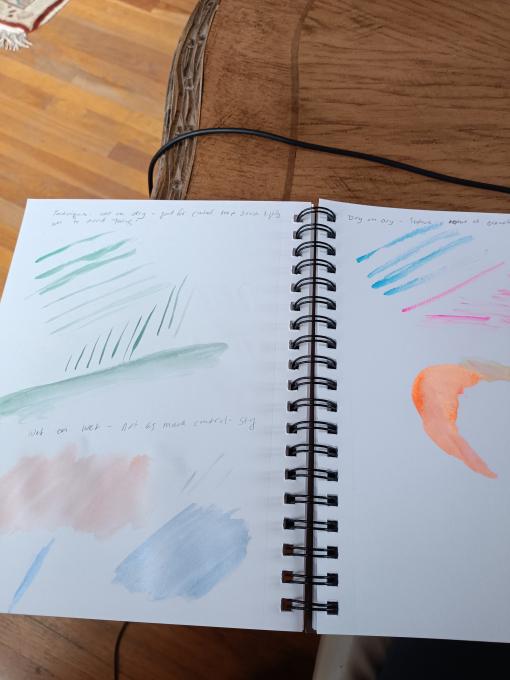

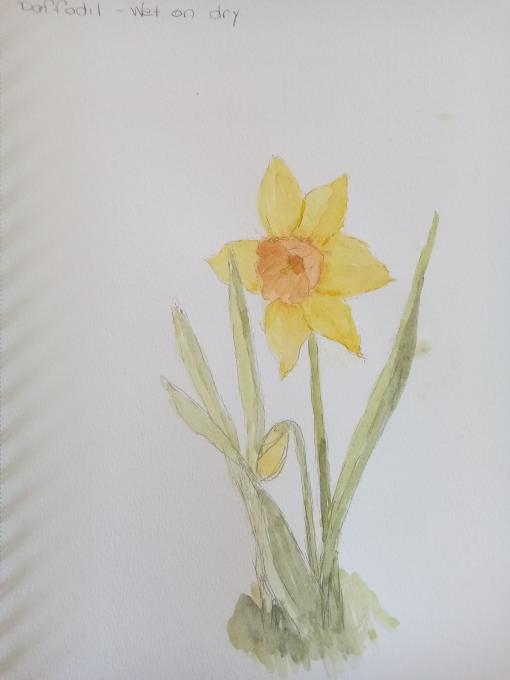



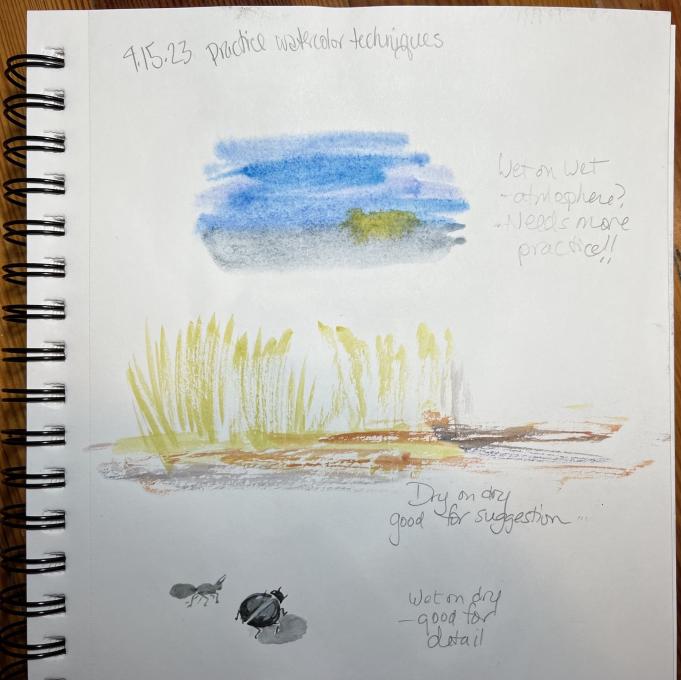 Below I attempted to capture the colors of an early spring day in Connecticut. The wet on wet worked well for suggesting the light foliage and sky, and wet on dry defined most of the shapes in my landscape. I wasn't able to achieve dry on dry with the water brush.
Below I attempted to capture the colors of an early spring day in Connecticut. The wet on wet worked well for suggesting the light foliage and sky, and wet on dry defined most of the shapes in my landscape. I wasn't able to achieve dry on dry with the water brush.

